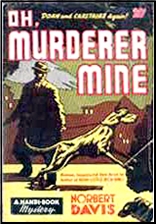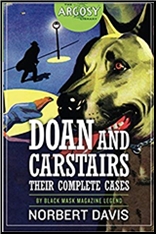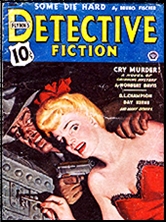Wed 19 Feb 2020
A Western Book! Movie!! Review by Dan Stumpf: ELMORE LEONARD “The Tall T” // Film (1957).
Posted by Steve under Reviews , Western Fiction , Western movies[12] Comments

THE TALL T (AND OTHER WESTERN ADVENTURES) Avon #775, 1957, featuring: “The Tall T†(originally “The Captivesâ€) by Elmore Leonard, 1955; “The Man from Gant’s Place†by Steve Frazee, 1951; “The Twilighters†by Noel M Loomis, 1954.
THE TALL T. Columbia, 1957. Randolph Scott, Maureen O’Sullivan, Richard Boone, Henry Silva, Arthur Hunnicutt, Skip Homeier, and John Hubbard. Screenoplay by Burt Kennedy from the story by Elmore Leonard. Directed by Budd Boetticher.
Whathehell does that title mean?
But leave that be for now. Perhaps it will convey the quality of the book if I say that the Elmore Leonard story, while quite good, is the least of the three here.
Leonard’s tale is a tight-knit saga of a hold-up-turned-kidnapping, with Rancher Pat Brennan reluctantly along for the ride as three killers hold heiress Doretta Mims for ransom and send her husband — Willard Mims, the name says it all — to make arrangements. The characters are well defined, the action deftly done, but it all seems a bit too terse, as if there were a novel inside this story, yearning to break out.

I will add though that I saw the film before reading the book, and my judgement may be more critically impaired than usual. More on this anon. For now I’ll just say, as if it needed saying, that Elmore Leonard knew how to write action and move a story fast without seeming rushed.
But “The Man from Gant’s Place†takes the prize here. A simple tale of a boy fresh off the farm walking into the middle of a range war, that overturns every cliché known to pulp writers. Steve Frazee isn’t well remembered among Western writers, but he had a way of looking at hard work and senseless gunplay that gave his stories depth as well as life, and this is one of his best.
And the book rounds off with one of the grimmest western stories I’ve ever read: “The Twilighters,†a narrative of dishonor among thieves filled with shocking brutality. Tough, scary and unforgettable.
I will add that the book is graced with a gaudy cover and loads of shots from the film, and conclude that it’s an attractive package indeed, and one worth seeking out.
***
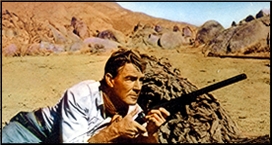
As for the movie made from it, this is a minority opinion, but I’ve always felt that the first twenty minutes were a waste of film, and watching them was a wanton squandering of my precious youth. But the film proper truly takes off when the three bad guys ooze out of the darkened swing station, and from there on it attains a high level of tension and feeling until (SPOILER ALERT!) Randolph Scott flushes them back into the darkness from whence they oozed at film’s end.
I say “tension†because The Tall T reels at the edge of violence like a drunk at a wedding, with Henry Silva as a killer who enjoys his work entirely too much, Skip Homeier as an outlaw too dumb to be honest, and Richard Boone as their leader, who doesn’t really want to kill Scott but knows he will have to do it in the end.
All four actors seem so at home in their parts that one doesn’t even notice them acting, and Maureen O’Sullivan matches them as the homely prize they must fight over. Arthur Hunnicutt tosses off another of his pitch-perfect performances as himself, and even John Hubbard, the forgettable leading man of The Mummy’s Tomb, has moments of rare and well-done intensity.
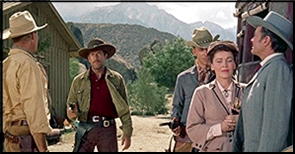
Best of all, writer Burt Kennedy fleshes out the empty spaces in Elmore Leonard’s story with genuine sensitivity. When Boone and Scott talk quietly about ranching and outlawry, they’re really talking about life itself and why they ended up on opposite sides of it. Boone in particular seems trapped in his role no less than his captives, and his confabs with Scott are as much a struggle for escape as Scott will undertake when the chips go flying.
The Tall T is, in short, what poets and philosophers call “a must-see†and though I have yet to figure out what the title means, it’s a film I can watch again and again with pleasure.

